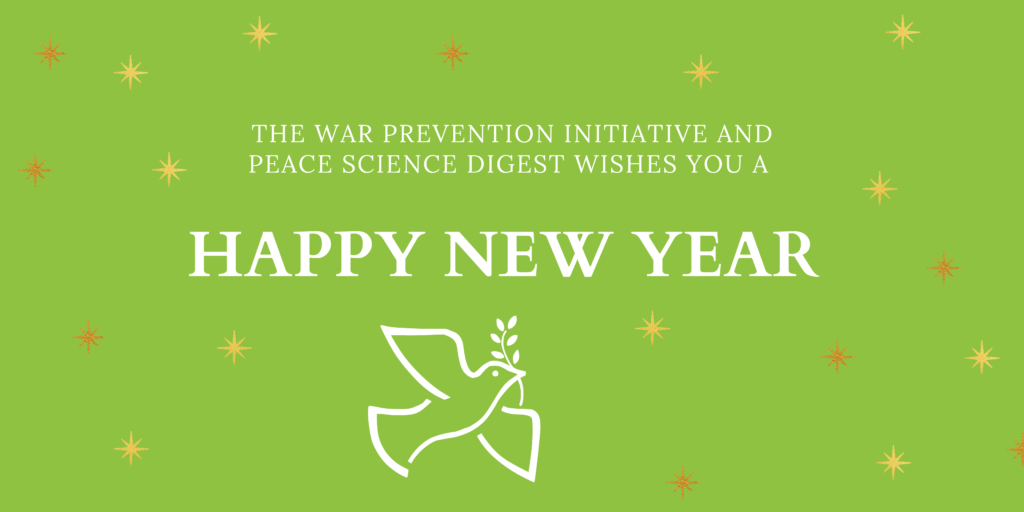
January 3, 2022
Dear Friends,
A little over ten years ago, we set out on an experiment to advance our bold peace agenda guided by a vision to prevent all war. Our strategy to shift the world collectively from war to peace are met by profound challenges posed by overwhelmingly militaristic and racists approaches in U.S. foreign policy. As we embark on a new year, we reflect on the larger context of our work, our vision for a more just and peaceful future, and our key projects for the year ahead.
What are the militaristic approaches in U.S. foreign policy? The U.S. has fought 247 wars, combat, and other combat actions abroad from 1776 to the present in an endless cycle of perpetual war.[1] There are approximately 800 U.S. military bases abroad many of which are beyond governmental oversight.[2] Nuclear weapons are considered the bedrock of security with the U.S. maintaining 5,550 nuclear weapons.[3] The environmental footprint of the military is unconscionable: for instance, the U.S. Department of Defense is the third largest water polluter in America, having dumped 63,335,653 pounds of poison into waterways from 2010-2014.[4] The military budget is hollowing out our economy at nearly $900 billion a year with little Congressional resistance. A prospering arms industry profits from war and militarism–the return on stocks of Lockheed Martin during the Afghanistan War was 1,236%.[5]
These measurable entry points set the larger context for our work, coalitions, and campaigns that we are part of to challenge the insanity of war. Wars can be prevented, bases can be closed, nuclear weapons can be eliminated, and the military’s environmental impact can be addressed by simply reducing the size of the military, cutting the military budget, and divesting from the arms industry.
When we examine racism and militarism in a larger paradigm, we are facing even more complex obstacles that are deeply embedded in existing belief systems, economic structures, and political institutions. This was powerfully examined over a six-month period with a diverse working group convened by the Center for International Policy and the Friends Committee on National Legislation under the framework of Dismantling Racism and Militarism in U.S. Foreign Policy.
Through this working group, we saw the power and possibility of dismantling the domestic and foreign policy silos (e.g., peace, justice, environment, labor, veterans, and immigration), and advanced a positive vision grounded in equality, rights, dignity, justice, shared wealth, and sustainability.
The overwhelming nature of U.S. militarism shows us where we must utilize our time, talents, and energy. Our key policy areas focus on existential threats to everyone’s security, like that of nuclear weapons or climate change. The development of a feminist foreign policy offers paradigm-transforming change and a viable alternative to U.S militarism and racism.
What we need to build is complicated yet clear, transformative yet achievable, and urgent yet takes time. What we cannot afford is to continue the collective business-as-usual.
What’s ahead?
- A new annotated bibliography on demilitarizing security and a literature review on racism in U.S. foreign policy
- A video on peace systems for sustainable peace
- A War Prevention Initiative & One Earth Future Speaker Series
- Year seven of our Peace Science Digest with continued bi-weekly analyses and newsletters, special issue collaborations, and Research to Action posts
We are profoundly grateful and privileged to call the War Prevention Initiative of the Jubitz Family Foundation our organizational home. Here, we prosper as peace professionals and advocates; and can bring our full selves as individuals who want to change the world–just like you.
We will end with this year-end note with a haiku we co-created at the beginning of 2021 with key words on peace:
Justice achieved is
when peacebuilding works for all
and the local is no trauma but nonviolence;
planet’s dialogue
With best wishes from War Prevention Initiative,
Patrick, Kelsey, Kristin, Erica, and Molly
Peace Science Digest Year in Review
To celebrate the new year, we reflect on the 28 analyses that we published in 2021. Listed below are the most viewed analysis and the editorial team’s top choices. View our top analyses here:
Top Viewed Analyses in 2021
- Evaluating Conflict Transformation in the Nigeria Oil Region
- How Successful Was the Global War on Terror? Evidence of a Backlash Effect
- Existing Peace Systems Demonstrate Peaceful Intergroup and International Relationships Are Possible
- African Religious Philosophy as a Resource for Peacebuilding
- Women Acting to Dismantle Violent Extremism
Editors’ Choice Analyses in 2021
- The Disruptive and Visionary Peacebuilding Discourse of U.S. Representative Barbara Lee
- Artificial Intelligence in U.S. Counterterrorism and the Inescapable Fog of (Endless) War
- Lessons Learned from the Law Enforcement Response to Far-Right Terrorism: Insights for a More Effective Approach
- The Role of Transformative Reparations in Building Justice and Sustainable Peace
- Prisons as a Training Ground for Nonviolent Resistance in Protracted Conflicts
